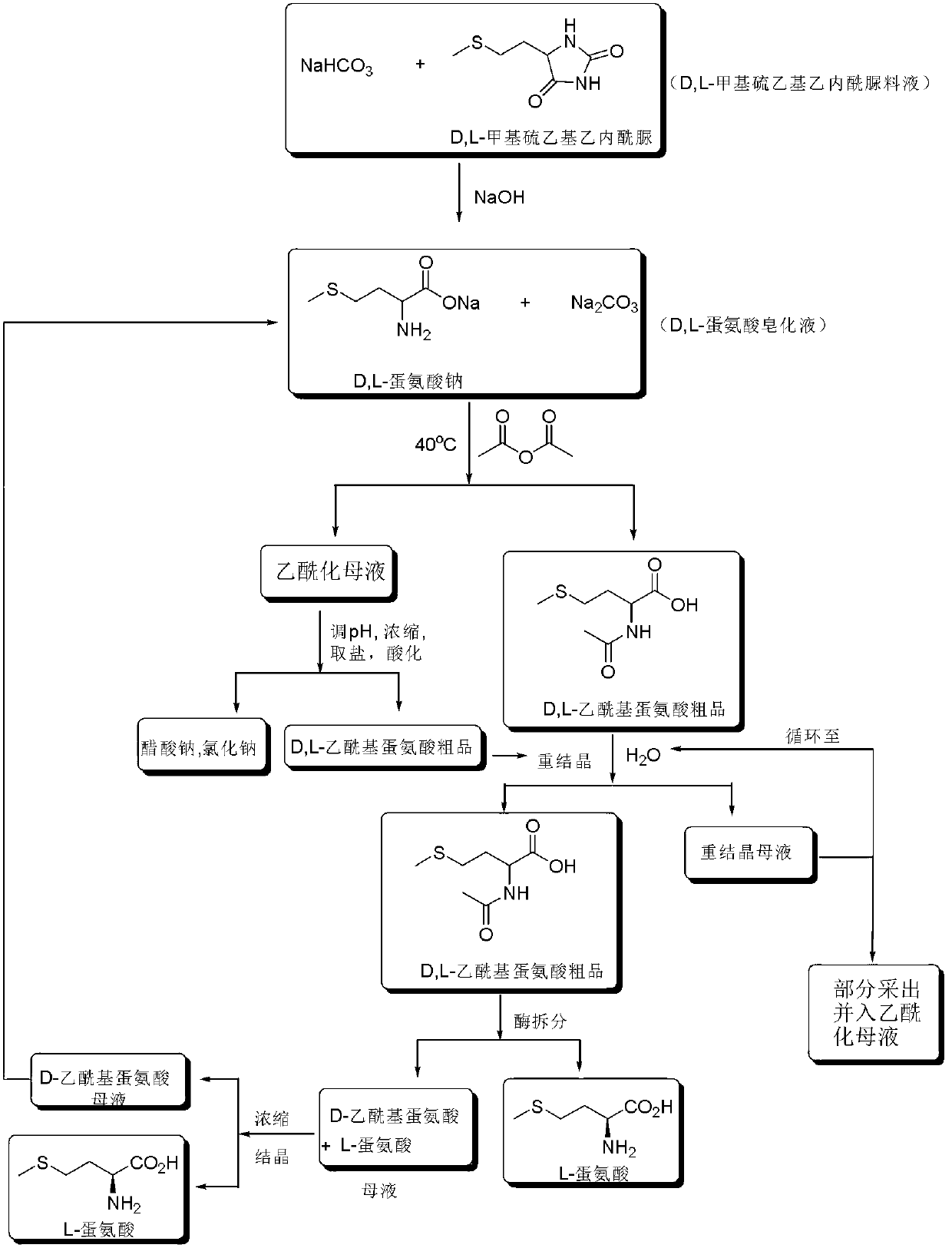Method for preparing L-methionine by using acetylated saponification solution
A technology of acetylmethionine and acetylmethionine, which is applied in the chemical industry, can solve the problems of increasing the cost of L-methionine, and achieve the effects of low production cost, high speed and high purity
- Summary
- Abstract
- Description
- Claims
- Application Information
AI Technical Summary
Problems solved by technology
Method used
Image
Examples
Embodiment 1
[0043] The 5-(2-methylthioethyl)-hydantoin (Ziguang Tianhua Methionine Co., Ltd.) was decolorized with activated carbon and then hydrolyzed with sodium hydroxide to obtain the saponified solution. For example, after adding sodium hydroxide, heat the hydrolysis reaction system to 130°C to 165°C to fully hydrolyze. The saponified solution obtained by hydrolysis is directly used in the following examples to produce D,L-acetylmethionine.
[0044] The saponification solution is composed of the following components: 17%±2% by mass of L,D-methionine sodium, 11%±2% by mass of sodium carbonate, and the rest of the water medium.
Embodiment 2
[0046] Get 200 kilograms of saponification liquid after the decolorization mentioned in embodiment 1, analyze the composition of saponification liquid: D, the content of L-sodium methionine is 15%, and sodium carbonate content is 10%, and surplus is water. The way of decolorization adopts activated carbon.
[0047] Slowly add 27 kg of acetic anhydride dropwise to the saponification solution to carry out the acetylation reaction, and control the reaction temperature at 45°C. During the reaction, the rate of addition is mainly controlled to avoid excessive bubbles. When the volume of acetic anhydride dropped to 1 / 2, a large number of carbon dioxide bubbles will be generated; the reaction time is 5 hours, and D,L-acetylmethionine sodium will be generated.
[0048] The reaction process was observed by thin-layer chromatography, the developer was n-butanol: water: acetic acid = 4:1:1, the chromogenic agent was ninhydrin chromogenic method, and the chromatographic plate was silica ...
Embodiment 3
[0050] Get 200 kilograms of saponification liquid after the decolorization mentioned in embodiment 1, analyze the composition of saponification liquid: D, the content of L-methionine sodium is 19%, and sodium carbonate content is 13%, and surplus is water.
[0051] Slowly add 27 kg of acetic anhydride dropwise to the saponification solution to carry out the acetylation reaction. Control the reaction temperature at 35°C. During the reaction, the rate of addition is mainly controlled to avoid excessive bubbles. When the volume of acetic anhydride dropped to 1 / 2, a large number of carbon dioxide bubbles will be generated; the reaction time is 5 hours, and D,L-acetylmethionine sodium will be generated.
[0052] The reaction process was observed by thin-layer chromatography, the developer was n-butanol: water: acetic acid = 4:1:1, the chromogenic agent was ninhydrin chromogenic method, and the chromatographic plate was silica chromatographic plate . The acetylation rate of D,L-me...
PUM
 Login to View More
Login to View More Abstract
Description
Claims
Application Information
 Login to View More
Login to View More - R&D
- Intellectual Property
- Life Sciences
- Materials
- Tech Scout
- Unparalleled Data Quality
- Higher Quality Content
- 60% Fewer Hallucinations
Browse by: Latest US Patents, China's latest patents, Technical Efficacy Thesaurus, Application Domain, Technology Topic, Popular Technical Reports.
© 2025 PatSnap. All rights reserved.Legal|Privacy policy|Modern Slavery Act Transparency Statement|Sitemap|About US| Contact US: help@patsnap.com



